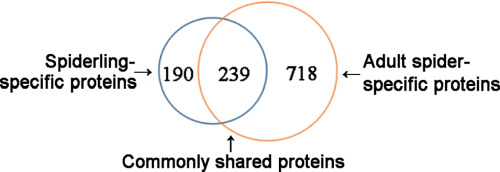当前位置:
X-MOL 学术
›
Comp. Biochem. Physiol. C Toxicol. Pharmacol.
›
论文详情
Our official English website, www.x-mol.net, welcomes your
feedback! (Note: you will need to create a separate account there.)
Comparative proteomic analysis to probe into the differences in protein expression profiles and toxicity bases of Latrodectus tredecimguttatus spiderlings and adult spiders.
Comparative Biochemistry and Physiology C: Toxicology & Pharmacology ( IF 3.9 ) Pub Date : 2020-04-03 , DOI: 10.1016/j.cbpc.2020.108762 Xiaozhen Peng 1 , Zhipan Dai 2 , Xianchun Wang 2
Comparative Biochemistry and Physiology C: Toxicology & Pharmacology ( IF 3.9 ) Pub Date : 2020-04-03 , DOI: 10.1016/j.cbpc.2020.108762 Xiaozhen Peng 1 , Zhipan Dai 2 , Xianchun Wang 2
Affiliation

|
The early reports and our previous work confirmed the existence of the toxic proteinaceous components in the body of the L. tredecimguttatus newborn and adult spiders. For revealing the differences in the protein expression profiles and toxicity bases of the spiders at different developmental stages, the spiderling and adult spider proteins were comparatively analyzed using a proteomic strategy. Totals of 429 and 958 proteins were identified from the spiderlings and adult spiders, respectively, with 239 proteins being identified from both of them. Although some similarities between the spiderling and adult spider proteomes exist, there are obvious differences between the two proteomes in size, complexity, molecular weight (MW) distribution, acid-base property, and hydropathicity, etc. Gene ontology (GO) analysis demonstrates that, comparing based on the percentages of proteins, the spiderling and adult spider proteins have generally similar distribution profiles with respect to the subcellular localization, molecular function and biological process. However, there are still some differences between these two sets of proteins in some classifications of the three GO categories. For the adult spiders, latrotoxins together with other toxins and toxin-like proteins, etc. constitute their toxicity basis, whereas the toxicity of the spiderlings depends mainly on the synergistic action of atypical latrotoxins and toxin-like proteins, most of which are different from those of the adult spiders, demonstrating that the spiders at different developmental stages have largely different toxicity mechanisms.
中文翻译:

比较蛋白质组学分析,以探究特氏十二指肠蜘蛛和成年蜘蛛蛋白质表达谱和毒性基础的差异。
早期的报道和我们以前的工作证实了特氏乳杆菌新生蜘蛛和成年蜘蛛体内存在有毒的蛋白质成分。为了揭示不同发育阶段蜘蛛的蛋白质表达谱和毒性基础的差异,使用蛋白质组学策略对蜘蛛和成年蜘蛛蛋白质进行了比较分析。分别从小蜘蛛和成年蜘蛛中鉴定出总共429和958种蛋白质,从这两种中鉴定出239种蛋白质。尽管蜘蛛和成人蜘蛛蛋白质组之间存在一些相似之处,但两个蛋白质组在大小,复杂性,分子量(MW)分布,酸碱性质和亲水性等方面存在明显差异。基因本体论(GO)分析表明,根据蛋白质的百分比进行比较,在亚细胞定位,分子功能和生物学过程方面,蜘蛛蛋白和成年蜘蛛蛋白通常具有相似的分布特征。但是,在这三个GO类别的某些分类中,这两套蛋白质之间仍然存在一些差异。对于成年蜘蛛,拉特毒素与其他毒素和类毒素蛋白等共同构成其毒性基础,而小蜘蛛的毒性主要取决于非典型拉特毒素和类毒素蛋白的协同作用,其中大多数与证明了处于不同发育阶段的蜘蛛具有不同的毒性机制。就亚细胞定位,分子功能和生物学过程而言,蜘蛛蛋白和成年蜘蛛蛋白通常具有相似的分布特征。但是,在这三个GO类别的某些分类中,这两套蛋白质之间仍然存在一些差异。对于成年蜘蛛,拉特毒素与其他毒素和类毒素蛋白等共同构成其毒性基础,而小蜘蛛的毒性主要取决于非典型拉特毒素和类毒素蛋白的协同作用,其中大多数与证明了处于不同发育阶段的蜘蛛具有不同的毒性机制。就亚细胞定位,分子功能和生物学过程而言,蜘蛛蛋白和成年蜘蛛蛋白通常具有相似的分布特征。但是,在这三个GO类别的某些分类中,这两套蛋白质之间仍然存在一些差异。对于成年蜘蛛,拉特毒素与其他毒素和类毒素蛋白等共同构成其毒性基础,而小蜘蛛的毒性主要取决于非典型拉特毒素和类毒素蛋白的协同作用,其中大多数与证明了处于不同发育阶段的蜘蛛具有不同的毒性机制。在三个GO类别的某些分类中,这两组蛋白质之间仍然存在一些差异。对于成年蜘蛛,拉特毒素与其他毒素和类毒素蛋白等共同构成其毒性基础,而小蜘蛛的毒性主要取决于非典型拉特毒素和类毒素蛋白的协同作用,其中大多数与证明了处于不同发育阶段的蜘蛛具有不同的毒性机制。在三个GO类别的某些分类中,这两组蛋白质之间仍然存在一些差异。对于成年蜘蛛,拉特毒素与其他毒素和类毒素蛋白等共同构成其毒性基础,而小蜘蛛的毒性主要取决于非典型拉特毒素和类毒素蛋白的协同作用,其中大多数与证明了处于不同发育阶段的蜘蛛具有不同的毒性机制。
更新日期:2020-04-06
中文翻译:

比较蛋白质组学分析,以探究特氏十二指肠蜘蛛和成年蜘蛛蛋白质表达谱和毒性基础的差异。
早期的报道和我们以前的工作证实了特氏乳杆菌新生蜘蛛和成年蜘蛛体内存在有毒的蛋白质成分。为了揭示不同发育阶段蜘蛛的蛋白质表达谱和毒性基础的差异,使用蛋白质组学策略对蜘蛛和成年蜘蛛蛋白质进行了比较分析。分别从小蜘蛛和成年蜘蛛中鉴定出总共429和958种蛋白质,从这两种中鉴定出239种蛋白质。尽管蜘蛛和成人蜘蛛蛋白质组之间存在一些相似之处,但两个蛋白质组在大小,复杂性,分子量(MW)分布,酸碱性质和亲水性等方面存在明显差异。基因本体论(GO)分析表明,根据蛋白质的百分比进行比较,在亚细胞定位,分子功能和生物学过程方面,蜘蛛蛋白和成年蜘蛛蛋白通常具有相似的分布特征。但是,在这三个GO类别的某些分类中,这两套蛋白质之间仍然存在一些差异。对于成年蜘蛛,拉特毒素与其他毒素和类毒素蛋白等共同构成其毒性基础,而小蜘蛛的毒性主要取决于非典型拉特毒素和类毒素蛋白的协同作用,其中大多数与证明了处于不同发育阶段的蜘蛛具有不同的毒性机制。就亚细胞定位,分子功能和生物学过程而言,蜘蛛蛋白和成年蜘蛛蛋白通常具有相似的分布特征。但是,在这三个GO类别的某些分类中,这两套蛋白质之间仍然存在一些差异。对于成年蜘蛛,拉特毒素与其他毒素和类毒素蛋白等共同构成其毒性基础,而小蜘蛛的毒性主要取决于非典型拉特毒素和类毒素蛋白的协同作用,其中大多数与证明了处于不同发育阶段的蜘蛛具有不同的毒性机制。就亚细胞定位,分子功能和生物学过程而言,蜘蛛蛋白和成年蜘蛛蛋白通常具有相似的分布特征。但是,在这三个GO类别的某些分类中,这两套蛋白质之间仍然存在一些差异。对于成年蜘蛛,拉特毒素与其他毒素和类毒素蛋白等共同构成其毒性基础,而小蜘蛛的毒性主要取决于非典型拉特毒素和类毒素蛋白的协同作用,其中大多数与证明了处于不同发育阶段的蜘蛛具有不同的毒性机制。在三个GO类别的某些分类中,这两组蛋白质之间仍然存在一些差异。对于成年蜘蛛,拉特毒素与其他毒素和类毒素蛋白等共同构成其毒性基础,而小蜘蛛的毒性主要取决于非典型拉特毒素和类毒素蛋白的协同作用,其中大多数与证明了处于不同发育阶段的蜘蛛具有不同的毒性机制。在三个GO类别的某些分类中,这两组蛋白质之间仍然存在一些差异。对于成年蜘蛛,拉特毒素与其他毒素和类毒素蛋白等共同构成其毒性基础,而小蜘蛛的毒性主要取决于非典型拉特毒素和类毒素蛋白的协同作用,其中大多数与证明了处于不同发育阶段的蜘蛛具有不同的毒性机制。











































 京公网安备 11010802027423号
京公网安备 11010802027423号